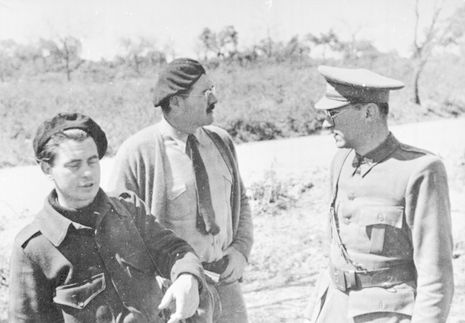‘Hemingway’ (2021) — documenting parts of a story
Arts Editor, Famke Veenstra-Ashmore, discusses the art of biographical filmmaking in a review of PBS’s new documentary about the literary giant

“But man is not made for defeat… A man can be destroyed but not defeated.” The Old Man and The Sea (1952).
Hemingway’s words are central to understanding the newly released PBS documentary, Hemingway (2021). The feature, while remaining frank and authentic, tells the tale of a misogynistic man who — through fame, self-induced marriage crises, and a seemingly eternal drinking habit — curated his own destruction. Yet through it all, he remained strikingly bold and determined to pursue what he felt was happiness. Nonetheless, to many the desires he embodied ultimately proved deeply misogynistic, and the epitome of disturbingly theatrical, toxic masculinity. And while the documentary certainly details how he destroyed his own life, there is an overarching sense of triumph in its conclusion — the myth of Hemingway fails to be defeated. A myth that although enduring, was somewhat built upon the inherently exclusive and sexist ‘great-man’ theory.
PBS’s Hemingway is episodic, stretching out the life of this troubled yet fascinating literary giant into six excruciating stages. We see his life detailed in an extraordinary way, beginning with the early onset of family troubles and youthful occupations, and ending with a string of ill-fated, often abusive (on his part) marriages, literary triumphs and flops — a chaos which followed him until his death. I describe these stages as excruciating, not because of their length, but rather because they seem so immersive that even as the viewer you become entangled into a myriad of experiences you will never have and feelings that you can only imagine. It is hard to reconcile your life with Hemingway’s, but somehow — in a way that is reminiscent of the novelist’s own style — the documentary achieves this.
“Preserving someone’s memory through film is a challenging prospect, and something I feel can be achieved in many ways”
Aside from the content of the documentary being revelatory, the production is inherently cinematic and wonderfully paced, offering the perfect mediation between interview, textual excerpts, and contemporary testimony. Featuring recounts from family members, seasoned scholars, and even the late military giant John McCain, it is an intense and thrilling watch and provides a balanced and authentic insight into the life of a man whose vocation — and vice — was to write. Through this format, the filmmakers are able to cover every aspect of his life, from his early days as a journalist in Kansas City, to his troubled final moments in Idaho. It feels like no rock is left unturned, and we receive the ambivalent portrait of a man, who in the attempt to mythologise himself, fractured his true identity in the process — becoming a violent, and in many ways frightening, figure. By paralleling his texts and experience, we also receive a comprehensive understanding of what built his character — and in turn, what broke it down.
This film, naturally, is not the first cinematic attempt at paying tribute to the late writer; it stems from a legacy of films, both of a fictitious and factual nature, that have arisen out of the cult-like interest that surrounds him. Yet, each of these iterations have somewhat fallen short of truly summarising and encapsulating Hemingway as both a man and a writer. Philip Kaufman’s television film, Hemingway & Gellhorn (2012), elicited mixed reviews and was brutally criticised for its obsessive focus on the melodramatic elements of his third marriage. Previous documentaries, such as Hemingway in Cuba (2011), while detailed and specific, lack the same scope which Hemingway (2021) is able to achieve. The digital chronicling of Hemingway’s life and work has thus far been underwhelming — a fact exacerbated by the endless storytelling potential which coloured his life.
Storytelling is certainly an element which the recent Hemingway pursues more successfully than previous films. Fundamentally, this is because it appears fearless — fearless of Hemingway and fearless of all his tempers and boundaries. It is not afraid to expose the veneer of the literary giant, praising him for what deserves praise, and scrutinising him for what deserves scrutiny. It does not linger too long on his exciting moments, nor dwells too long on the deeply depressing ones. It always gives a perspective to the products of Hemingway’s behaviour (damaged children and abandoned lovers and friends) in a way which makes the feature wholly intimate in its narration. Yet, it does not claim to be objective, either. It asserts itself as so far removed from Hemingway’s time that it just feels how it claims to be — a reconsideration of his life and times. Part of its authenticity comes from its factual basis, but this is not to say that fact is superior to fiction in preserving legacies. I have a deep respect and enjoyment for biographical films which are based on truth, and alter certain elements for dramatic effect. Often, this allows the resonance of a figure’s life to be truly felt — resulting in a far more emotive piece than a documentary could ever achieve. But where documentaries such as this lack in acting, they gain a certain starkness, which can be just as impactful.
Preserving someone’s memory through film is a challenging prospect, and something I feel can be achieved in many ways. Hemingway (2021) understands the importance of a multiplicity of perspectives in archiving a figure. In being transparent with their sources, the filmmakers craft a much more sophisticated version of Hemingway’s life for us to consume. However, it remains just that — a version of his life. We are never going to witness all angles of the story, it is a notion that can’t even be achieved through more narrative films such as Hemingway & Gellhorn (2012) which attempt to fill in the gaps. As a journalist himself, Hemingway would have understood the frustrations that come with never being able to tell the full story. Instead, we have to settle for the next best thing, part of the story — and Hemingway (2021) gives its all to preserve that part.
 News / Caius mourns its tree-mendous loss23 December 2025
News / Caius mourns its tree-mendous loss23 December 2025 Comment / Yes, I’m brown – but I have more important things to say22 December 2025
Comment / Yes, I’m brown – but I have more important things to say22 December 2025 News / Clare Hall spent over £500k opposing busway 24 December 2025
News / Clare Hall spent over £500k opposing busway 24 December 2025 Interviews / Politics, your own way: Tilly Middlehurst on speaking out21 December 2025
Interviews / Politics, your own way: Tilly Middlehurst on speaking out21 December 2025 News / King appoints Peterhouse chaplain to Westminster Abbey22 December 2025
News / King appoints Peterhouse chaplain to Westminster Abbey22 December 2025










